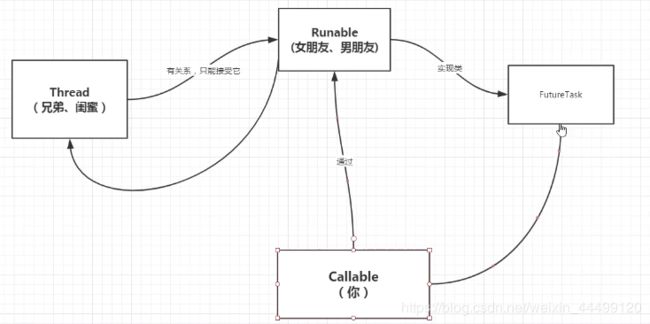JUC并发编程总结(一)
点我跳转至JUC并发编程总结(二)
JUC并发编程总结(一)
- 基础部分内容
- 线程和进程
- synchronized和Lock
- 1. 区别
- 2. 生产者消费者问题
- 3. 相关面试题
- 4. 小结
- 集合类线程不安全
- 解决方案
- 线程池和辅助类相关内容
- 线程类接口
- callable
- 常用辅助类及读写锁、队列
- 1. CountDownLatch
- 2. CyclicBarrier
- 3. Semaphore
- 4. 读写锁
- 5. 队列
- 线程池
- 工具类,三大方法。
- 七大参数
- 示例
- 线程设置
- Reference:
基础部分内容
线程和进程
- CPU密集型和IO密集型
- 获取cpu核心数
System.out.println(Runtime.getRuntime().availableProcessors()); - 线程的几个状态,打开Thread类看源码
public enum State { NEW, RUNNABLE, BLOCKED, WAITING,//等待 TIMED_WAITING,//等待超时 TERMINATED;//终止 } - sleep和wait区别
TimeUnit.SECONDS.sleep(5);
- 来自不同类 thread/Object
- 锁释放 不释放/释放
- 适用范围 任何地方/同步代码块
- 捕获异常 需要/不需要
synchronized和Lock
1. 区别
- synchronized是关键字,Lock是类
- synchronized无法判断锁状态,Lock可以判断是否获取到了锁
- synchronized会自动释放,Lock必须手动释放不然会死锁。
- synchronized会阻塞会一直等待,Lock不一定一直等待
- synchronized可重入锁非公平;Lock,可重入锁,可以判断锁,非公平(可以设置)
- synchronized适合少量代码同步问题,lock适合大量。

2. 生产者消费者问题
- synchronized版,防止虚假唤醒问题。判断有if替换为while
class Data {
private int num = 0;
public synchronized void increment() throws InterruptedException {
while (num != 0) { //防止虚假唤醒问题
this.wait();
}
num++;
System.out.println("生产了一个:" + num);
this.notifyAll();
}
public synchronized void decrement() throws InterruptedException {
while (num == 0) {
this.wait();
}
num--;
System.out.println("消费了一个:" + num);
this.notifyAll();
}
public static void main(String[] args) {
System.out.println(Runtime.getRuntime().availableProcessors());
Data data = new Data();
new Thread(() -> {
data.increment();
}).start();
new Thread(() -> {
data.decrement();
}).start();
}
}
- lock版生产者消费者问题
class Data2 {
private int num = 0;
Lock lock =new ReentrantLock();
Condition condition= lock.newCondition();
public void increment() {
try {
lock.lock(); //业务代码写在try里,这是模板
while (num != 0) { //防止虚假唤醒问题
condition.await();
}
num++;
System.out.println("生产了一个:" + num);
condition.signalAll();
} catch (InterruptedException e) {
e.printStackTrace();
}finally {
lock.unlock();
}
}
public void decrement() {
lock.lock();
try {
while (num == 0) {
condition.await();
}
num--;
System.out.println("消费了一个:" + num);
condition.signalAll();
} catch (InterruptedException e) {
e.printStackTrace();
}finally {
lock.unlock();
}
}
}
3. 相关面试题
- 两个线程同时给数组里写0到100。
public class Demo {
public static void add(List<Integer> a,Integer b){
a.add(b);
}
public static void main(String[] args) throws InterruptedException {
List<Integer> a=new LinkedList<>();
ReentrantLock lock=new ReentrantLock();
Condition condition1 = lock.newCondition();
Condition condition2 = lock.newCondition();
AtomicInteger num= new AtomicInteger(1);
Thread t1= new Thread(()->{
for (int i=0;i<100;i++){
lock.lock();
try {
while (num.get() !=1){
condition1.await();
}
if (i%2==0){
add(a,i);
num.set(2);
}
condition2.signal();
} catch (InterruptedException e) {
e.printStackTrace();
}finally {
lock.unlock();
}
}
});
Thread t2= new Thread(()->{
for (int i=0;i<100;i++){
lock.lock();
try {
while (num.get()!=2){
condition2.await();
}
if (i%2!=0){
add(a,i);
num.set(1);
}
condition1.signal();
} catch (InterruptedException e) {
e.printStackTrace();
}finally {
lock.unlock();
}
}
});
t1.start();
t2.start();
t1.join();
t2.join();
System.out.println(a);
}
}
4. 小结
- condition,精准唤醒。如上线程加减问题。
- 8锁现象,锁的是谁?
- synchronized锁的对象是方法调用者。
集合类线程不安全
- 普通集合类用多线程操作会出现并发修改异常。
ConcurrentModificationException
解决方案
List<String> list =new Vector<>();
List<String> list2 = Collections.synchronizedList(new ArrayList<>());
List<String> list3 =new CopyOnWriteArrayList<>();
Set<String> set =Collections.synchronizedSet(new HashSet<>());
Set<String> set2 =new CopyOnWriteArraySet<>();
ConcurrentHashMap<String,String> map=new ConcurrentHashMap<>();
线程池和辅助类相关内容
线程类接口
callable
- 示例:
public class Demo { public static void main(String[] args) throws ExecutionException, InterruptedException { MyThread thread =new MyThread(); FutureTask ft=new FutureTask(thread); new Thread(ft,"A00").start(); String result= (String) ft.get(); FutureTask ft2=new FutureTask(new MyThread()); new Thread(ft2,"A01").start(); String result2= (String) ft.get(); } } class MyThread implements Callable<String>{ @Override public String call() throws Exception { return "返回泛型接口的String类"; } }
常用辅助类及读写锁、队列
1. CountDownLatch
- 是通过一个计数器来实现的,计数器的初始值是线程的数量。每当一个线程执行完毕后,计数器的值就-1,当计数器的值为0时,表示所有线程都执行完毕,然后在闭锁上等待的线程就可以恢复工作了。
- 示例:
public class Demo03 {
public static void main(String[] args) throws InterruptedException {
CountDownLatch cdl=new CountDownLatch(5); //倒计时为5
for (int i = 0; i <10 ; i++) {
new Thread(()->{
System.out.println(Thread.currentThread().getName()+"线程执行完成");
cdl.countDown();
}).start();
}
cdl.await();
System.out.println("exit");
}
}
2. CyclicBarrier
- 大概的意思就是一个可循环利用的屏障。它的作用就是会让所有线程都等待完成后才会继续下一步行动。
- 示例:
CyclicBarrier cb=new CyclicBarrier(5,()->{
System.out.println("五个县城全部执行完成!");
//会执行2次,可以设置执行定期任务。
});
for (int i = 0; i <10 ; i++) {
new Thread(()->{
System.out.println(Thread.currentThread().getName()+"线程执行完成");
cb.await(); //try..catch
}).start();
}
3. Semaphore
- Semaphore 是一个计数信号量,必须由获取它的线程释放。常用于限制可以访问某些资源的线程数量,例如通过 Semaphore 限流。Semaphore 只有3个操作:初始化、增加、减少。
- 示例:
public class StudySemaphore {
public static void main(String[] args) {
ExecutorService executorService = Executors.newCachedThreadPool();
//信号量,只允许 3个线程同时访问
Semaphore semaphore = new Semaphore(3);
for (int i=0;i<10;i++){
final long num = i;
executorService.submit(new Runnable() {
@Override
public void run() {
try {
//获取许可
semaphore.acquire();
//执行
System.out.println("Accessing: " + num);
Thread.sleep(new Random().nextInt(5000)); // 模拟随机执行时长
//释放
semaphore.release();
System.out.println("Release..." + num);
} catch (InterruptedException e) {
e.printStackTrace();
}
}
});
}
executorService.shutdown();
}
}
4. 读写锁
ReadWriteLock同Lock一样也是一个接口,提供了readLock和writeLock两种锁的操作机制,一个是只读的锁,一个是写锁。- 读锁可以在没有写锁的时候被多个线程同时持有,写锁是独占的(排他的)。每次只能有一个写线程,但是可以有多个线程并发地读数据。
- 所有读写锁的实现必须确保写操作对读操作的内存影响。换句话说,一个获得了读锁的线程必须能看到前一个释放的写锁所更新的内容。
- 互斥原则:
- 读-读能共存 (但不能写)
- 读-写不能共存 (脏读、不可重复读、幻读)
- 写-写不能共存 (显然不能…)
5. 队列
SynchronousQueue<String> blockingDeque= new SynchronousQueue<String>();
new Thread(()->{
blockingDeque.put("1"); //try...catch
blockingDeque.put("2");
blockingDeque.put("3");
},"生产者").start();
new Thread(()->{
System.out.println("消费了:"+blockingDeque.take());
System.out.println("消费了:"+blockingDeque.take());
System.out.println("消费了:"+blockingDeque.take());
},"消费者").start();
线程池
工具类,三大方法。
ExecutorService tp1= Executors.newSingleThreadExecutor(); //单个线程
ExecutorService tp2= Executors.newFixedThreadPool(5); //创建线程池大小
ExecutorService tp3= Executors.newCachedThreadPool(); //遇强则强,遇弱则弱
for (int i = 0; i <50 ; i++) {
tp1.execute(()->{
System.out.println(Thread.currentThread().getName()+"ok");
});
}
七大参数
- 我们打开
ThreadPoolExecutor构造方法,可以看到这七大参数。public ThreadPoolExecutor(int corePoolSize, //核心线程数 int maximumPoolSize, //最大线程数 long keepAliveTime, //空闲等待时间 TimeUnit unit, //空闲等待时间单位 BlockingQueue<Runnable> workQueue, //工作队列 ThreadFactory threadFactory, //使用的工程, RejectedExecutionHandler handler //队列满了的时候拒绝策略。 ) { if (corePoolSize < 0 || maximumPoolSize <= 0 || maximumPoolSize < corePoolSize || keepAliveTime < 0) throw new IllegalArgumentException(); if (workQueue == null || threadFactory == null || handler == null) throw new NullPointerException(); this.acc = System.getSecurityManager() == null ? null : AccessController.getContext(); this.corePoolSize = corePoolSize; this.maximumPoolSize = maximumPoolSize; this.workQueue = workQueue; this.keepAliveTime = unit.toNanos(keepAliveTime); this.threadFactory = threadFactory; this.handler = handler; } - 关于拒绝策略,提供了以下几个。
new ThreadPoolExecutor.AbortPolicy(); //队列满了,抛出异常 new ThreadPoolExecutor.CallerRunsPolicy(); //哪来回哪去,一般丢给主线程 new ThreadPoolExecutor.DiscardOldestPolicy(); //丢列满了丢掉任务,不抛出异常 new ThreadPoolExecutor.DiscardPolicy(); //队列满了,尝试和最早的竞争资源
示例
ExecutorService pool=new ThreadPoolExecutor(3,
5,
3, TimeUnit.SECONDS,
new LinkedBlockingDeque<>(),
Executors.defaultThreadFactory(),
new ThreadPoolExecutor.CallerRunsPolicy());
for (int i = 0; i <50 ; i++) {
int finalI = i;
pool.execute(new Thread(()->{
System.out.println(Thread.currentThread().getName()+"------"+ finalI);
try {
TimeUnit.SECONDS.sleep(5);
} catch (InterruptedException e) {
e.printStackTrace();
}
}));
}
线程设置
- cpu密集型:几核就是几,保证占用率最高。
- io密集型:应该大于你程序中十分消耗io的线程。例如下载任务。
Reference:
- https://www.jianshu.com/p/333fd8faa56e
- https://www.jianshu.com/p/e233bb37d2e6
- https://www.jianshu.com/p/ec637f835e08
- https://blog.csdn.net/j080624/article/details/82790372
- https://blog.csdn.net/youanyyou/article/details/78990156




